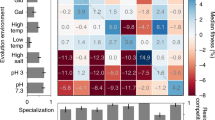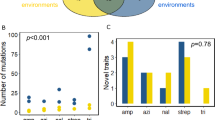Abstract
TEMPERATURE is an important environmental factor affecting all organisms1,2, and there is ample evidence from comparative physiology that species1,3 and even conspecific populations4,5 can adapt genetically to different temperature regimes. But the effect of these adaptations on fitness and the rapidity of their evolution is unknown, as is the extent to which they depend on pre-existing genetic variation rather than new mutations. We have begun a study of the evolutionary adaptation of Escherichia coli to different temperature regimes, taking advantage of the large population sizes and short generation times in experiments on this bacterial species6–10. We report significant improvement in temperature-specific fitness of lines maintained at 42 °C for 200 generations (about one month). These changes in fitness are due to selection on de novo mutations and show that some biological systems can evolve rapidly in response to changes in environmental factors such as temperature.
This is a preview of subscription content, access via your institution
Access options
Subscribe to this journal
Receive 51 print issues and online access
$199.00 per year
only $3.90 per issue
Buy this article
- Purchase on Springer Link
- Instant access to full article PDF
Prices may be subject to local taxes which are calculated during checkout
Similar content being viewed by others
References
Hochachka, P. W. & Somero, G. N. Biochemical Adaptation (Princeton University Press, Princeton, New Jersey, 1984).
Cossins, A. R. & Bowler, K. Temperature Biology of Animals (Chapman and Halt, London, 1987).
Prosser, C. L. Adaptational Biology: Molecules to Organisms (Wiley, New York, 1986).
Powers, D. A. in New Directions in Ecological Physiology (eds Feder, M. E., Bennett, A. F., Burggren, W. W. & Huey, R. B.) 102–130 (Cambridge University Press, New York, 1987).
Watt, W. B. Am. Nat. 125, 118–143 (1985).
Novick, A. & Szilard, L. Proc. natn. Acad. Sci. U.S.A. 36, 708–719 (1950).
Atwood, K. C., Schneider, L. K. & Ryan, F. J. Proc. natn. Acad. Sci. U.S.A. 37, 146–155 (1951).
Dykhuizen, D. E. & Hartl, D. L. Microbiol. Rev. 47, 150–168 (1983).
Lenski, R. E. Evolution 42, 425–432 (1988).
Lenski, R. E. Evolution 42, 433–440 (1988).
Carlton, B. C. & Brown, B. J. in Manual for Methods for General Microbiology (ed. Gerhardt, P.) 222–242 (Am. Soc. Microbiol., Washington DC, 1981).
Cohan, F. M. & Hoffmann, A. A. Genetics 114, 145–163 (1986).
Falconer, D. S. Introduction to Quantitative Genetics (Longman, Essex, 1981).
Sokal, R. R. & Rohlf, F. J. Biometry (Freeman, San Francisco, 1981).
Ryan, F. J. & Kiritani, K. J. gen. Microbiol. 20, 644–653 (1959).
Maynard Smith, J. J. theor. Biol. 30, 319–335 (1971).
Moran, P. A. P. The Statistical Processes of Evolutionary Theory (Oxford University Press, Oxford, 1962).
Huey, R. B. & Hertz, P. E. Evolution 38, 441–444 (1984).
Huey, R. B. & Kingsolver, J. G. Trends Ecol. Evol. 4, 131–135 (1989).
National Research Council, Carbon Dioxide Assessment Committee. Changing Climate (National Academy, Washington DC, 1983).
Abrahamson, D. E. The Challenge of Global Warming (Island, Washington DC, 1989).
Author information
Authors and Affiliations
Rights and permissions
About this article
Cite this article
Bennett, A., Dao, K. & Lenski, R. Rapid evolution in response to high-temperature selection. Nature 346, 79–81 (1990). https://doi.org/10.1038/346079a0
Received:
Accepted:
Issue Date:
DOI: https://doi.org/10.1038/346079a0
This article is cited by
-
Quantifying thermal adaptation of soil microbial respiration
Nature Communications (2023)
-
Photonic structures in radiative cooling
Light: Science & Applications (2023)
-
Eco-evolutionary responses of the microbial loop to surface ocean warming and consequences for primary production
The ISME Journal (2022)
-
Understanding metabolic adaptation by using bacterial laboratory evolution and trans-omics analysis
Biophysical Reviews (2020)
-
Community-level respiration of prokaryotic microbes may rise with global warming
Nature Communications (2019)
Comments
By submitting a comment you agree to abide by our Terms and Community Guidelines. If you find something abusive or that does not comply with our terms or guidelines please flag it as inappropriate.



